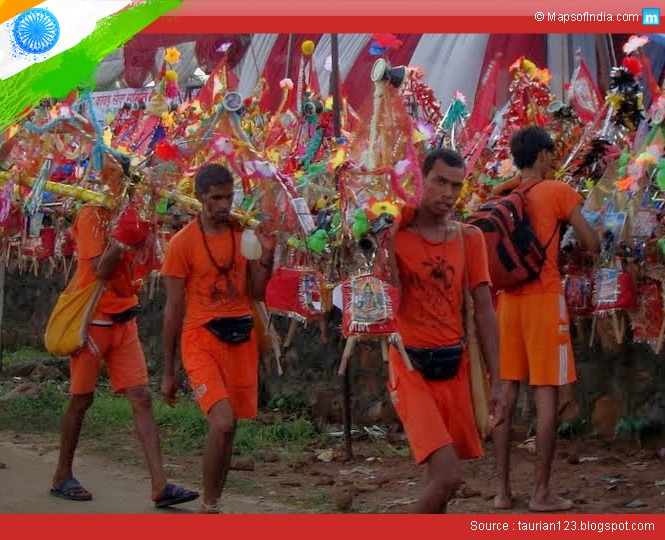
With due respect to the religious sentiments of many, like every year, the saawan month becomes a month of chaos, commotion and nuisance for citizens of Delhi and NCR. Every year, in July, the auspicious Saawan month according to the Hindu calendar, is highlighted by a spectrum of saffron robes all around the city, including Moradabad, Lucknow, Meerut etc. Saawan month is the month of Lord Shiva and we see a large number of devotees of Lord Shiva: some walking barefoot, some in cars or trucks with loud music and some in the makeshift camps on the roads. Popularly known as Kaavad or Kanwad Yatra, the devotees, referred as Kanwariyas, are from the neighbouring states like Punjab, Haryana, Bihar, Jharkhand, Madhya Pradesh, camping in Delhi, before leaving for their homes with the holy Ganges water. This time, the Kaavad yatra started on July 17, 2019 and ended on July 30, 2019. Each year, the Kaavad yatra is growing in size and the spectacle of saffron colour all over Delhi is delightful to watch (if we ignore the traffic chaos).
The Ritual
The word “Kaavad” or “Kaawad” stems from the Sanskrit word “kawadrathi”. Kaavad means a single pole on which ends, a pot is hanged. According to the ritual, the kanwariyas collect holy water of River Ganga from places like Haridwar, Gangotri, Rrishikesh in pots and carry the covered pots on a beautifully decorated kaavad or pole, balancing it by carrying it across their shoulders. During the entire journey from Haridwar, till they reach their homes, the Kanwariyas are not allowed to put the pots on the ground. Infact, they take turns to hold the poles from each other while taking rest. This holy water is then poured on Shivling in the Shiv temples located in their hometowns or nearby localities. While in procession, we can hear the various chants by these pilgrims in praise of Lord Shiva like as “Har Har Mahadev”, “Bam Bam Bhole” or “Bol Bam”.
The Kaavad’s History in North India
The Kaawad Yatra takes place in the month of Shravan as this is the month solely dedicated to Lord Shiva. This was the month when Lord Shiva, drank the poison after “churning of the ocean” and distributed the nectar or amrit of immortality to the devas or gods. It is said that after consuming the poison, Lord Shiva felt a burning sensation in his throat and he turned blue. It was then, all devas and gods (some say, it’s Ravana) brought Ganga water and poured it over him to cool him down. This tradition has been followed since then. The devotees or the kanwariyas bring Gangajal and pour it on Lord Shiva’s Linga as mark of respect and thanksgiving and get His blessings in return.
Present Scenario
This pilgrimage for all Lord Shiva’s devotees started on a very small scale in the past. But with time, this yatra has grown into a larger affair. Infact, Kanwariyan Yatra can be considered as one of the world’s largest religious processions of the Hindus, and this became all the more lavish and extravagant after the Ramjanambhumi-Babri Masjid controversy in the 1990s. Today, various voluntary organisations, Hindu organisations like as the Rashtriya Swayam Sewak Sangh, KanwarSsanghs, and the Vishwa Hindu Parishad set up tents for the pilgrims along the national highways and other roads, where they are offered food, shelter and medical help. The number of devotees is increasing day by day.
The traffic police and the police department as a whole keep a strict vigil on the smooth running of the yatra. In fact, there are instances of the Kanwariyas resorting to violence in the past for any kind of provocation. Thankfully, this time there were no news of such untoward incidents happening during the yatra, barring a few small ones. The yatra ended on a peaceful note.
Kavadi Festival in South India
On the similar lines of Kanwariya Yatra in North India, there is another important festival celebrated in Tamil Nadu, South India. This is known as Kavadi and here Lord Muruga is worshipped. It is performed during Thaipusam festival, on the full moon usually in the months of January or February. This year, Kavadi was celebrated on January 21.
Like the Kaavad, the Kavadi is usually a wooden stick with two baskets hanged at each ends. There is another variation of the Kavadi like as a palanquin beautifully decorated with flowers and bells. Unlike the Kanwariyas in North India, the Kavadi bearers maintain silence and the only sounds that can be heard are the soft tingling of the bells hanging on the kavadis. The two baskets contain rice, milk or other items that the kavadi bearers offer to Lord Muruga. These items are collected by the devotees by begging from house to house. They travel on foot for long distances till their baskets are full. The people who place the articles in the baskets also receive the blessings. The Kavadi-bearer observes celibacy, eats satwik food, do not take intoxicating drinks, do not smoke and all the time he thinks only of God during this festival. Some bearers take up extreme steps like as piercing sharp pointed objects in their cheeks, bodies, and tongues. They do this so that they can constantly think about Lord Muruga. The kavadi festival is a major crowd pulling festival in Tamil Nadu and is also celebrated in other countries like Sri Lanka, Singapore, Mauritius, Malaysia etc.
Related Information:




